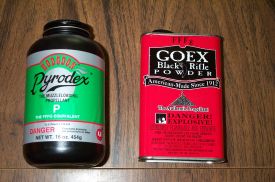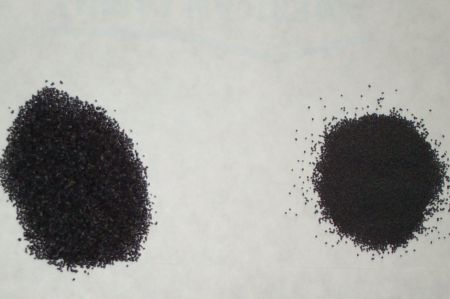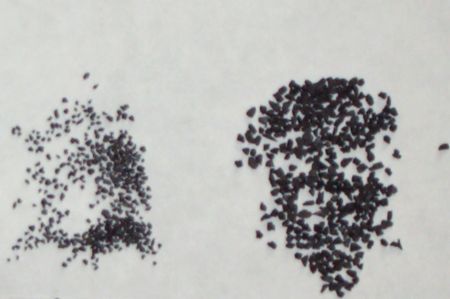
Pyrodex and Goex FFFG powder cans
*Black Powders*
To begin with, we want to look at the different types of black powder out there. First, you have the actual black powder made in the same way it was during the last century. Probably the most popular brand name would be Goex.
Black powder has several granulation sizes to it. FFFFG (or what most people call 4F) is the finest powder. Because of its small size, it burns the fastest and is mainly used in the flash pans of the older flintlock rifles and pistols. It’s purpose here is as a booster charge in order to fire the main charge by first being ignited by the sparks from the flint. The flash of the 4F powder going off also gets into the flash hole and this is what detonates your main charge. Due to it’s fast burning rate and higher pressures, do NOT use this as a main charge in your weapons. You might get away with it once or twice but with its higher pressures, you are running a risk of having an overloaded weapon and a catastrophic failure sooner or later.
The next larger size of powder is FFFG (or 3F) powder. This is a little coarser than the 4F powder and burns a little slower without as much pressure. The main use for this powder is in pistols and revolvers. With their shorter barrels, this faster burning powder is used to achieve better ballistics than the coarser powders. Yes, you can use coarser powders in a revolver but because the coarser the powder the more bulky it is, your charge will not be as strong as it could be. 3F also has the advantage that it works well in rifles of .45 caliber and smaller though it should not be used in caliber’s larger than that.

Here is where you also get into the “fake” black powder as well. Pyrodex is probably the most common one seen and is sold as “P” size when it comes to the 3F-size powder. Pyrodex has the advantage of not being as sensitive to shock and static electricity as actual black powder as well as not having as much fouling as original black powder either. This is what accounts for its popularity among many shooters however the purists tend to avoid it.

Next we move onto FFG (2F) or the R/S Pyrodex equivalent. Here the size of the powder granules is getting slightly larger than 3F. This is going to give slower burning rates and are mainly used in muzzle loading rifles and shotguns. 2F powder is also used many times in reloading black powder cartridges as well.

Finally we come to the largest size which is FG (1F). Many people refer to this powder as burquet or charcoal powder since the size of the granules is very large. The place this powder is used is mainly in large bore weapons like cannons. The Frontier Army of the Dakotas that I am a scout for has for instance a 12-pound Napoleon cannon out at Fort Lincoln that we fire each year for the tourists. Here our artillery uses about a pound of this powder in the gun for one very loud blank charge! Other than this sort of use though it is rare that many black powder shooters will ever use this stuff.
So there you have a look at the different powders used in black powder shooting. In the next part, we’ll look at a common black powder revolver and how to load and fire it.
Grunt
All materials at this site not otherwise credited are Copyright © 1996 - 2001 Trip Williams. All rights reserved. May be reproduced for personal use only. Use of any material contained herein is subject to stated terms or written permission.